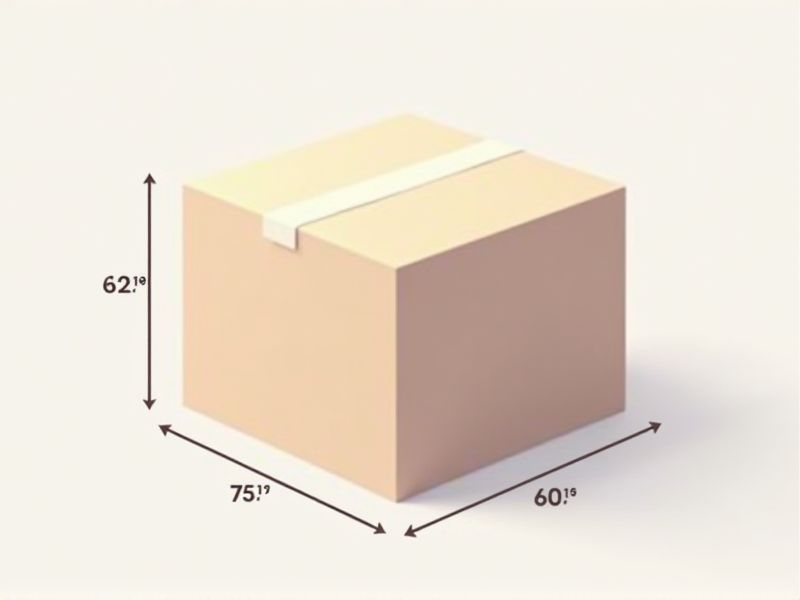
When selecting or designing a box, understanding standard dimensions helps ensure compatibility with storage, shipping, or shelving needs. Common corrugated shipping boxes, for example, often come in sizes like 12x12x12 inches, 16x12x8 inches, or 18x18x16 inches (length x width x height). Choosing a standard size not only simplifies sourcing and reduces costs but also helps with efficient stacking and space utilization. Be sure to measure your contents carefully and allow a little extra room for protective packaging materials, especially if you're shipping fragile items.
Length
The standard box dimensions typically emphasize length, with the most common measurements being 12 inches, 24 inches, and 36 inches. When selecting a box, it's crucial to consider that the length can significantly impact your storage and shipping efficiency. For instance, a 24-inch box can accommodate a variety of items while optimizing space utilization. Remember, the length you choose not only affects capacity but also influences handling and transport logistics.
Width
The standard box dimensions prioritize a width of 12 inches, allowing for optimal storage and versatility in various applications. With a depth of 10 inches and a height of 8 inches, this design accommodates a range of items while maintaining stability. Each box can hold up to 15 pounds, making it suitable for both personal and professional use. By focusing on width, you maximize accessibility, ensuring that items are easily retrievable and organized efficiently.
Height
When considering box dimensions, height is a critical measurement that can significantly influence storage capacity and aesthetic appeal. A standard box height typically ranges from 4 to 12 inches, accommodating various items from documents to small appliances. For effective storage solutions, ensure your box height aligns with the intended use and available space in your home or office. Evaluating the height alongside width and depth can optimize your organizational efficiency.
Volume
The standard box volume, typically measured in cubic units, is crucial for a variety of applications, from shipping to storage solutions. For instance, a standard box measuring 12 inches in height, 12 inches in width, and 12 inches in depth has a volume of 1,728 cubic inches, making it ideal for transporting small to medium-sized items. Understanding the volume helps in optimizing space utilization, enabling you to maximize efficiency and reduce shipping costs. Accurate volume calculations can also assist in ensuring compliance with shipping regulations and minimizing waste.
Aspect Ratio
Aspect ratio is a critical parameter when designing a box, particularly in packaging and display solutions, with common ratios including 4:3, 16:9, and 1:1. A well-defined aspect ratio ensures your box fits seamlessly within a given space, optimizing both aesthetics and functionality. For example, a 16:9 ratio is ideal for multimedia packaging, while the square 1:1 ratio is prevalent in social media contexts, enhancing visual integrity. By aligning your box design with the appropriate aspect ratio, you can significantly improve user experience and product presentation.
Capacity
The standard box capacity typically measures 12 to 24 inches in height and width, accommodating various storage needs. According to industry guidelines, a standard box can hold up to 1,200 cubic inches, making it suitable for items such as supplies, equipment, or personal belongings. When selecting a box, consider your specific requirements; for example, using a box with a capacity of 18 inches in height can provide ample space for books or documents. Your choice of box capacity can significantly affect organization and accessibility, ensuring that everything fits snugly without unnecessary wastage of space.
Material Thickness
Box focus standards vary significantly based on material thickness, which typically ranges from 0.5 mm to 10 mm for common packaging applications. The structural integrity of the box correlates directly with its thickness; as thickness increases, so does resistance to deformation and durability. For example, a 3 mm thick cardboard box can withstand a compression strength of approximately 32 kg, making it ideal for shipping heavy items. Ensuring your box meets these standards will enhance both shipping efficiency and product protection.
Weight Limit
The standard weight limit for shipping boxes typically ranges from 50 to 70 pounds, depending on the box's dimensions and material quality. This weight capacity ensures the integrity and safety of the contents during transit. For example, corrugated cardboard boxes with reinforced edges have a higher weight tolerance compared to regular paper boxes. When choosing a box for your shipping needs, always consider the total weight and distribution of the items inside to prevent damage.
Tolerance
The standard of box dimensions typically emphasizes tolerance levels, ensuring that measurements are precise for optimal functionality. For instance, a tolerance of +-0.5 mm is common, allowing for slight variations in manufacturing while maintaining product integrity. This precision is critical in industries like electronics or automotive, where even minor discrepancies can affect performance. You benefit from understanding these standards, as they play a significant role in quality control and component compatibility.
Stacking Strength
The stacking strength of a box is crucial for ensuring that it can support the weight of products without collapsing. This strength is typically measured in pounds per square inch (psi), with standards indicating that a box should withstand a minimum of 200 psi for effective stacking. High-quality materials and proper construction techniques can enhance the stacking strength, allowing you to safely store and transport goods. Implementing the correct design and testing methods can significantly improve the overall durability and reliability of your packaging solutions.
